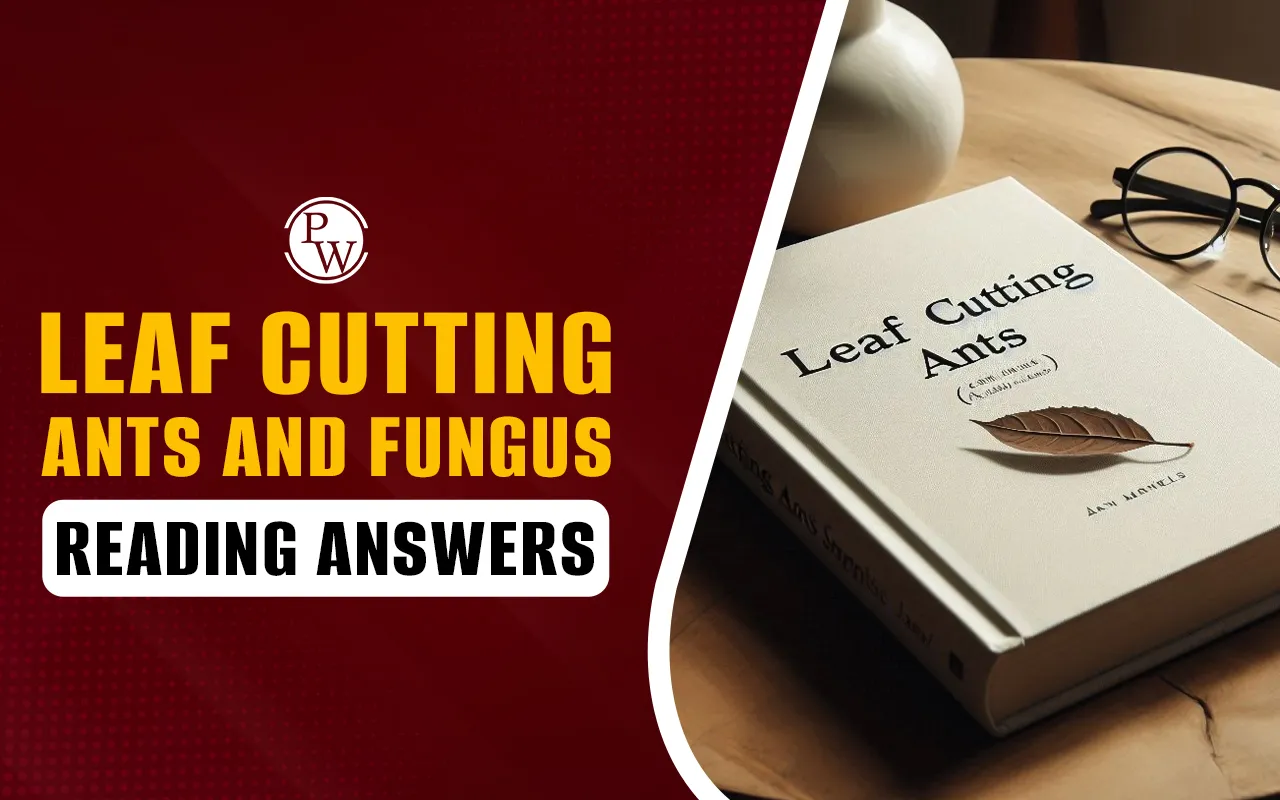
Leaf Cutting Ants and Fungus Reading Answers: The IELTS Reading test includes three reading passages designed to assess a candidate’s comprehension skills. “Leaf Cutting Ants and Fungus Reading Answers” is a significant topic that explores the fascinating relationship between leaf-cutting ants and the fungus they cultivate. This passage includes 13 questions divided into three sections: Matching Information, Summary Completion, and Matching Features. Here, we have provided a sample passage and answers to help IELTS aspirants practice effectively and improve their reading accuracy. Solving these questions will enhance your understanding and boost your IELTS band score.
Leaf Cutting Ants and Fungus Reading Answers Passage
Leaf-Cutting Ants And Fungus Reading Passage
Paragraph A: Although the ants and their agriculture have been extensively studied over the years, more recent research has revealed intriguing new information about the fungus they grow, how they domesticated it, and how they maintain it free of pathogens. For instance, it turns out that the fungus farms that the ants were supposed to keep clean of pathogens are susceptible to destructive mold only found in ant nests. The ants long ago made a discovery to control the mold that would be a credit to any pharmaceutical laboratory.
Paragraph B: The mutual dependence of two species, exemplified by leaf-cutting ants and their fungus farms, is a wonder of nature. It is also the most well-known example of symbiosis. The accomplishment of the ants is noteworthy - biologist Edward O. Wilson has referred to it as "one of the major breakthroughs in animal evolution" - because it enables them to consume the otherwise poisoned harvest of tropical forests, whose leaves are laden with terpenoids, alkaloids, and other chemicals designed to sicken browsers.
Paragraph C: Because all gardening ants are members of the same tribe and are therefore descended from the first fungus farmer, fungus farming appears to have only occurred once throughout evolution. The attine ant tribe consists of more than 200 species, categorized into 12 groups or genera. The groups that are known as the lower attines, whose nests are smaller and their methods more rudimentary, feed their gardens with detritus like dead leaves, insects, and feces. The leaf-cutters use fresh vegetation. A group of four biologists, including Ulrich G. Mueller, Ted R. Schultz, Ignacio H. Chapela, and Stephen A. Rehner from the US Department of Agriculture, examined the DNA of ant funguses in 1994. They discovered that the widely held belief that fungi are all descended from a single strain is only partially accurate.
Paragraph D: The fungus that caused leaf-cutting was in fact descended from a single strain and had at least 23 million years of clonal or simple budding reproduction. However, the four biologists found that the lower attine ants used various strains of the fungus, including in one instance a completely different species. Mr. Currie thought that Cameron R. Currie, a Ph.D. candidate at the University of Toronto, resembled the monocultures of different human crops, which are very productive for a while before succumbing to some terrible pathogen, like the Irish potato blight. Monocultures are easy prey for parasites because they lack the genetic diversity to adapt to changing environmental threats. Mr. Currie believed that the ant-fungus system must contain a parasite. The theory, however, received no support from a century of ant research. Books explain how leaf-cutter ants meticulously rid their gardens of any unwelcome creatures. "You know the ants keep their gardens free of parasites, don't you?" people kept saying to me. Mr. Currie spoke of his efforts to track down a covert intruder.
Paragraph E: Attine ant gardens are far from infection-free, Mr. Currie found after three years of searching through them. He and two colleagues, Dr. Mueller, and David Mairoch, isolated a number of alien organisms that were published in the Proceedings of the National Academy of Sciences last month, particularly a family of parasitic molds known as Escovopsis. Escovopsis is a pathogen that is extremely virulent and can completely destroy a fungus garden in a matter of days. It grows like a white cloud, obscuring the garden beneath it. The entirety of the garden is engulfed in a day or two. “Other ants avoid it, and the ants connected to the garden simply starve to death,” according to Dr. Rehner. “Except for those who have saved their larvae, they just seem to give up.”
Paragraph F: Evidently, Escovopsis and other parasites are typically managed by ants. Escovopsis will, however, quickly emerge if there is any loss of control or if the ants are eliminated. Even though brand-new leaf-cutter gardens begin free of Escovopsis, within two years, about 60% of them contract the disease. Escovopsis's function has been discovered, which raises our understanding of the evolution of attine ants to a new level. Dr. Schultz noted that evolutionary biologists have become more conscious of parasites' function as evolutionary catalysts over the past ten years. The lower attine species may now have a good explanation for why they frequently domesticate new fungi in their mushroom gardens in order to stay one step ahead of the tenacious Escovopsis.
Paragraph G: Curiously, Mr. Currie discovered that while the lower attines had more Escovopsis infections, the leaf-cutters generally had fewer alien molds in their gardens. They appear to be paying a higher risk of developing Escovopsis as a result of cultivating a pure variety of fungus. However, the leaf-cutters may not have much of a choice because they raise a unique type of fungus that, in contrast to those raised by the lower attines, produces nutritious swollen tips for the ants to consume.
Paragraph H: The question of how the attine ants, particularly the leaf-cutters, control this potentially harmful invader is raised by the discovery of a third partner in the ant-fungus symbiosis. Amazingly, Mr. Currie has once more offered the solution. The cuticle, or outer layer of the insect's body, is a whitish growth that has been observed on ants for a century, according to Dr. Mueller. "Some people might compare this to cuticular wax. But Cameron was the first person in a century to examine these things in detail. He could tell it wasn't inert wax. It has life. Since it is the source of half the antibiotics used in medicine, Mr. Currie discovered a specialized patch on the ants' cuticle that harbors a specific type of bacterium, one that is well-known to the pharmaceutical industry. Mr. Cameron and associates isolated a species of Streptomyces bacterium from each of the 22 attine ant species they studied, and they published their findings in Nature in April. For the most part, Streptomyces has little impact on common laboratory fungi. However, it is an effective spore suppressor and growth inhibitor of Escovopsis. The bacterium, Streptomyces, may have been a part of their symbiosis for almost as long as the Escovopsis mold because both the leaf-cutters and the lower attines use it. If this is the case, an ant probably discovered antibiotics millions of years before humans did. The ants are currently achieving two feats that are unattainable by human technology. The leaf-cutters successfully cultivate a monoculture year after year, and they use an antibiotic ostensibly so wisely and prudently that, unlike people, they do not cause the target pathogen to develop antibiotic resistance.
| IELTS Exam Important Links | |
|---|---|
| IELTS Reading Band Score | IELTS Listening Band Score |
| IELTS Speaking Band Score | IELTS Writing Band Score |
Leaf Cutting Ants and Fungus Reading Answers Sample Questions
Questions 1–6
Use the information in the passage to match the options (listed A–C) with the activities or features of ants below.
Write the appropriate letters A–C in boxes 1–6 on your answer sheet.
Options:
A – Cultivating and maintaining fungus gardens
B – Managing threats from parasites
C – Utilizing bacteria for protection
-
The activity that allows ants to feed on toxic leaves.
-
The method ants use to defend against Escovopsis.
-
The process ants follow to grow specific types of fungus.
-
The reason why leaf-cutter ants are vulnerable to Escovopsis.
-
The role played by Streptomyces in ant symbiosis.
-
How ants adjust to changing environmental threats.
Questions 7–11
The reading passage has eight paragraphs (A–H).
Which paragraph contains the following information?
Write the correct letter A–H in boxes 7–11 on your answer sheet.
-
Explanation of why leaf-cutter ants’ monoculture is at risk from parasites.
-
Reference to a discovery involving a third party in the ant-fungus relationship.
-
Details about the evolution of fungus farming among attine ants.
-
How Escovopsis spreads quickly and its effects on ant colonies.
-
Description of how leaf-cutter ants avoid infections despite growing monocultures.
Questions 12–13
Choose the correct letter, A, B, C, or D.
Write your answers in boxes 12–13 on your answer sheet.
-
According to the passage, why did Mr. Currie’s theory about parasites face skepticism?
A. Previous studies had not identified any parasite.
B. Ants were believed to have a natural immunity.
C. The fungus was thought to be genetically resistant to parasites.
D. The theory contradicted earlier research on ant behavior. -
What makes the relationship between leaf-cutter ants and Streptomyces bacteria unique?
A. The bacteria prevent other ants from invading the garden.
B. The bacteria produce antibiotics that target specific pathogens.
C. The bacteria grow only in ant nests.
D. The bacteria have evolved independently from the ants' behavior.
Leaf Cutting Ants and Fungus Reading Answers with Explanations
1. The activity that allows ants to feed on toxic leaves.
Answer: A (Cultivating and maintaining fungus gardens)
Location: Paragraph B
Reference: "The accomplishment of the ants is noteworthy... because it enables them to consume the otherwise poisoned harvest of tropical forests."
Explanation: Ants cultivate fungus to break down toxic compounds in leaves, making them safe to eat.
2. The method ants use to defend against Escovopsis.
Answer: B (Managing threats from parasites)
Location: Paragraph F
Reference: "Escovopsis will, however, quickly emerge if there is any loss of control or if the ants are eliminated."
Explanation: Ants manage threats from Escovopsis by maintaining control over their gardens and removing infections.
3. The process ants follow to grow specific types of fungus.
Answer: A (Cultivating and maintaining fungus gardens)
Location: Paragraph C
Reference: "The leaf-cutters use fresh vegetation."
Explanation: Leaf-cutter ants grow a specific type of fungus by providing fresh plant material.
4. The reason why leaf-cutter ants are vulnerable to Escovopsis.
Answer: B (Managing threats from parasites)
Location: Paragraph G
Reference: "They appear to be paying a higher risk of developing Escovopsis as a result of cultivating a pure variety of fungus."
Explanation: Monoculture farming by leaf-cutter ants makes them more vulnerable to parasitic infections.
5. The role played by Streptomyces in ant symbiosis.
Answer: C (Utilizing bacteria for protection)
Location: Paragraph H
Reference: "Mr. Currie discovered a specialized patch on the ants' cuticle that harbors a specific type of bacterium."
Explanation: Streptomyces bacteria produce antibiotics that protect ant gardens from Escovopsis.
6. How ants adjust to changing environmental threats.
Answer: A (Cultivating and maintaining fungus gardens)
Location: Paragraph F
Reference: "The lower attine species may now have a good explanation for why they frequently domesticate new fungi."
Explanation: Ants domesticate new strains of fungus to adapt to environmental changes and threats from parasites.
7. Explanation of why leaf-cutter ants’ monoculture is at risk from parasites.
Answer: Paragraph D
Reference: "Monocultures are easy prey for parasites because they lack the genetic diversity to adapt to changing environmental threats."
Explanation: Monoculture farming makes leaf-cutter ants vulnerable to pathogens due to low genetic diversity.
8. Reference to a discovery involving a third party in the ant-fungus relationship.
Answer: Paragraph H
Reference: "The question of how the attine ants, particularly the leaf-cutters, control this potentially harmful invader is raised by the discovery of a third partner in the ant-fungus symbiosis."
Explanation: The discovery of Streptomyces bacteria as a protective agent forms a third element in the ant-fungus relationship.
9. Details about the evolution of fungus farming among attine ants.
Answer: Paragraph C
Reference: "Fungus farming appears to have only occurred once throughout evolution."
Explanation: The passage outlines the evolutionary background of fungus farming in ants.
10. How Escovopsis spreads quickly and its effects on ant colonies.
Answer: Paragraph E
Reference: "Escovopsis is a pathogen that is extremely virulent and can completely destroy a fungus garden in a matter of days."
Explanation: Escovopsis spreads rapidly, causing devastation in ant colonies.
11. Description of how leaf-cutter ants avoid infections despite growing monocultures.
Answer: Paragraph H
Reference: "Mr. Currie discovered a specialized patch on the ants' cuticle that harbors a specific type of bacterium."
Explanation: The Streptomyces bacteria on ants’ bodies protect their gardens from infections.
12. According to the passage, why did Mr. Currie’s theory about parasites face skepticism?
Answer: A. Previous studies had not identified any parasite.
Location: Paragraph D
Reference: "The theory, however, received no support from a century of ant research."
Explanation: Earlier research had failed to identify any parasites in ant gardens.
13. What makes the relationship between leaf-cutter ants and Streptomyces bacteria unique?
Answer: B. The bacteria produce antibiotics that target specific pathogens.
Location: Paragraph H
Reference: "Mr. Currie discovered a specialized patch on the ants' cuticle that harbors a specific type of bacterium… It is an effective spore suppressor and growth inhibitor of Escovopsis."
Explanation: The Streptomyces bacteria produce targeted antibiotics to protect ant gardens from Escovopsis.
Also Read:
- Should You Use All Capital Letters in the IELTS Listening and Reading Tests
- IELTS Reading Mistakes
- How to Improve IELTS Reading Score
- How to Manage Time in IELTS Reading
Guidance of PW IELTS
Physics Wallah offers multiple online IELTS courses for all students. Follow the IELTS pages to better prepare for the exam.
| What is IELTS Exam? | Documents Required for IELTS Registration |
| IELTS exam eligibility requirements | IELTS Exam Fees |
| IELTS test results | IELTS Exam Pattern |
Leaf Cutting Ants and Fungus Reading Answers FAQs
What is the relationship between leaf-cutting ants and fungus?
How do leaf-cutting ants protect their fungus gardens from infections?
Why are leaf-cutter ants at higher risk of Escovopsis infections?
What is the significance of Escovopsis in the ant-fungus relationship?











